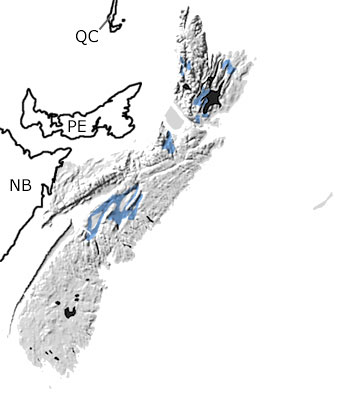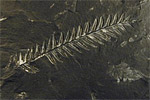Paleontology and geologyDuring the Carboniferous, all the continents were being pushed or pulled together to form the supercontinent, Pangea. Laurentia was colliding with Gondwana, with Nova Scotia between them, in the mountain-building episode called the Alleghenian Orogeny. As mountains were being pushed up, basins were dropped down and igneous rocks were intruded in several areas. Carboniferous rocks are common in Nova Scotia, although some may be grouped into "undifferentiated" rock units on this map. Early Carboniferous rocks are made up of multiple layers of pebbly conglomerates, sandstones, shales, and thin coals. Fossils of fish scales, ostracods, and moisture-loving plants like lycopods (scale trees) are evidence that these rocks were deposited in rivers and lakes. They can now be seen along the shore of the Bay of Fundy to the west. When ancient seas flooded parts of Nova Scotia, they left behind typical marine deposits, such as sandstone, shale, and limestone. Fossils of horn corals and other marine invertebrates can be found in these rocks. Several times, the sea became so shallow that the water evaporated, leaving behind salt and gypsum deposits, which are economically important today. Late Carboniferous rocks indicate an ancient landscape of swamps, rivers, floodplains, and lakes. Raindrop impressions, ripple marks, and fossils of arthropods, ostracods, bivalves, and plants are common.
The Late Carboniferous sandstones, shales, and coals at Joggins Fossil Cliffs in the northwest are world-renowned for preserving a snapshot of life during this period. Forests and swamps dominated by scale trees, giant club mosses, seed ferns, and horsetails covered this area. They were filled with large insects like the two-meter-long millipede, Arthropleura, and giant dragonfly-like Meganeura. A variety of early amphibians and reptiles lived here as well, including Dendrerpeton and Hylonomus, among others. The muddy areas around lakes and rivers were perfect for preserving their tracks. Bones of the early amphibians and reptiles living in these forests and swamps are also preserved, even small microsaurs that got trapped in tree trunks. |





